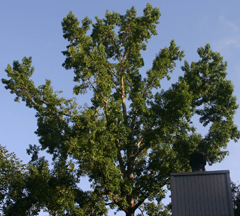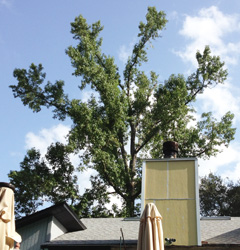Home > Pruning shade trees > Reducing the canopy > Reducing canopy applications > Reducing a mature tree
Reducing a mature tree
Large or very old trees can often be reduced in leu of removing them. This reduces risk of failure while allowing people to enjoy the attributes of large or very old trees. Large reduction cuts may be required in some cases. Although heading cuts are the least desirable type of pruning cut on mature trees due to the potential for decay following pruning, they are sometimes necessary to accomplish objectives (See: Details of heading cuts).
Before pruning
|
After reduction
|
| This 80' tall sweetgum tree was struck by lightning 12 years ago. There is a dead section of bark in the lower 35 feet of the main trunk that extends down into the root system. Roots are dead on 35% of the circumference of the trunk as a result. The canopy is full of foliage. The tree can be reduced and thinned at the top to reduce risk of failure so it can be retained in the landscape. | Pruning cuts 3 to 9 inches (see photo below) in diameter were made in the top one-third of the canopy. Pruning cuts included reduction and removal cuts. This reduces the overturning moment at the base of the tree and reduces the likelihood of failure. Occasionally, heading cuts can be used selectively to reduce certain sections of the crown if there are few other options. |



